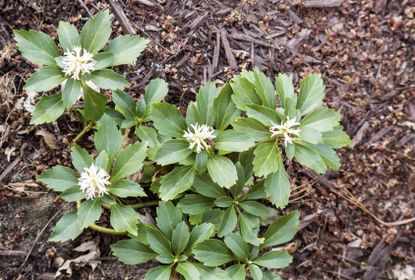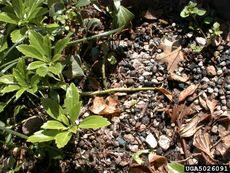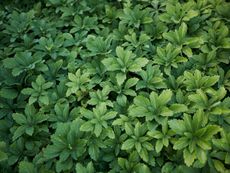Pachysandra Weeds: Tips For Removing Pachysandra Ground Cover


Pachysandra, also called Japanese spurge, is an evergreen ground cover that looks like a great idea when you plant it--after all, it stays green year-round and spreads quickly to fill an area. Unfortunately, this aggressive plant doesn't know when to stop. Read on for information on removing pachysandra ground cover. Pachysandra is an invasive perennial ground cover that spreads throughout the garden by means of underground stems and roots. Once it gets a foothold in the garden, it is very difficult to control. Pachysandra plants can overrun your garden and escape into wild areas where it displaces native plants.
How to Get Rid of Pachysandra in the Garden
If you find your garden overrun with this ground cover, then you'll need to know how to control pachysandra plant. There are three ways to get rid of pachysandra in the garden, and none of them are particularly pleasant. Dig it up. Digging is hard work, but it is environmentally safe and works well in small areas. Pachysandra has a shallow root system. To make sure you get all of the roots, cut through the foliage and remove the top 4 to 6 inches (10-15 cm.) of soil across the area where the plants grow. Cover it with black plastic. The soil under the plastic will heat up, and the plastic will deprive the plants of sunlight and water. The drawback is that it is unsightly, and it takes three months to a year to completely kill the plants. Plants in shady areas require the most time. Kill it with chemicals. This is a method of last resort, but if your choice is between using chemicals or giving your landscape over to pachysandra weeds, this may be an option for you.
Pachysandra Removal Tips Using Chemicals
Unfortunately, you'll have to use a systemic herbicide to get rid of pachysandra. This kills any vegetation it comes in contact with, so use it carefully. If you spray it on, choose a calm day so the wind won't carry it to other plants. Don't use the herbicide where it may run off into bodies of water. If you have herbicide left over, store it in its original container and out of the reach of children. Note: Chemical control should only be used as a last resort, as organic approaches are more environmentally friendly.
Gardening tips, videos, info and more delivered right to your inbox!
Sign up for the Gardening Know How newsletter today and receive a free download of our most popular eBook "How to Grow Delicious Tomatoes."

Jackie Carroll has written over 500 articles for Gardening Know How on a wide range of topics.
-
 Urban Beekeeping Guide: Top Tips For Raising Bees In The City
Urban Beekeeping Guide: Top Tips For Raising Bees In The CityUrban beekeeping can be a rewarding and appreciated pastime, but first be sure it’s legal in your city and learn the ropes of beekeeping.
By Mary Ellen Ellis
-
 2024 Plant Of The Year: Why Experts Say Philodendron Is The “It” Plant Of The Year
2024 Plant Of The Year: Why Experts Say Philodendron Is The “It” Plant Of The YearWe aren’t surprised that philodendron was designated the plant of the year. Versatile, easy-care and lovely, it’s the houseplant of the year 2024!
By Bonnie L. Grant
-
 Treating Volutella Blight On Pachysandra: What Is Pachysandra Volutella Blight
Treating Volutella Blight On Pachysandra: What Is Pachysandra Volutella BlightWhen pachysandra is stressed by too much water on its leaves or too little water to drink, it is prone to certain infectious diseases, including pachysandra Volutella blight. For more information about this disease and treatment, click here.
By Teo Spengler
-
 Growing Pachysandra Plants - How To Plant Pachysandra Ground Cover
Growing Pachysandra Plants - How To Plant Pachysandra Ground CoverPachysandra is a favorite ground cover plant in hard-to-plant areas such as under trees, or in shady areas with poor or acidic soil. Read here to find tips for growing pachysandra in your landscape.
By Susan Patterson